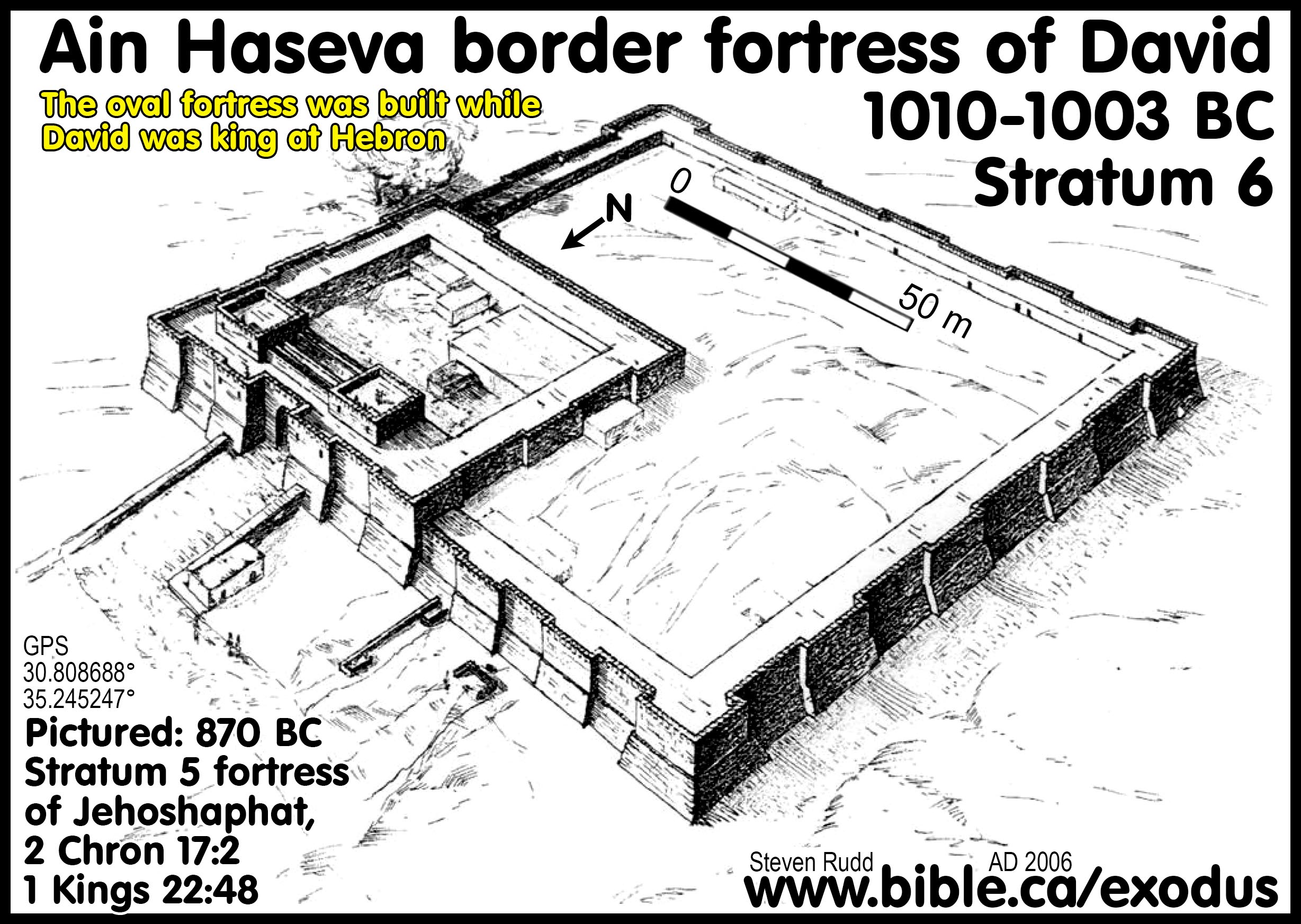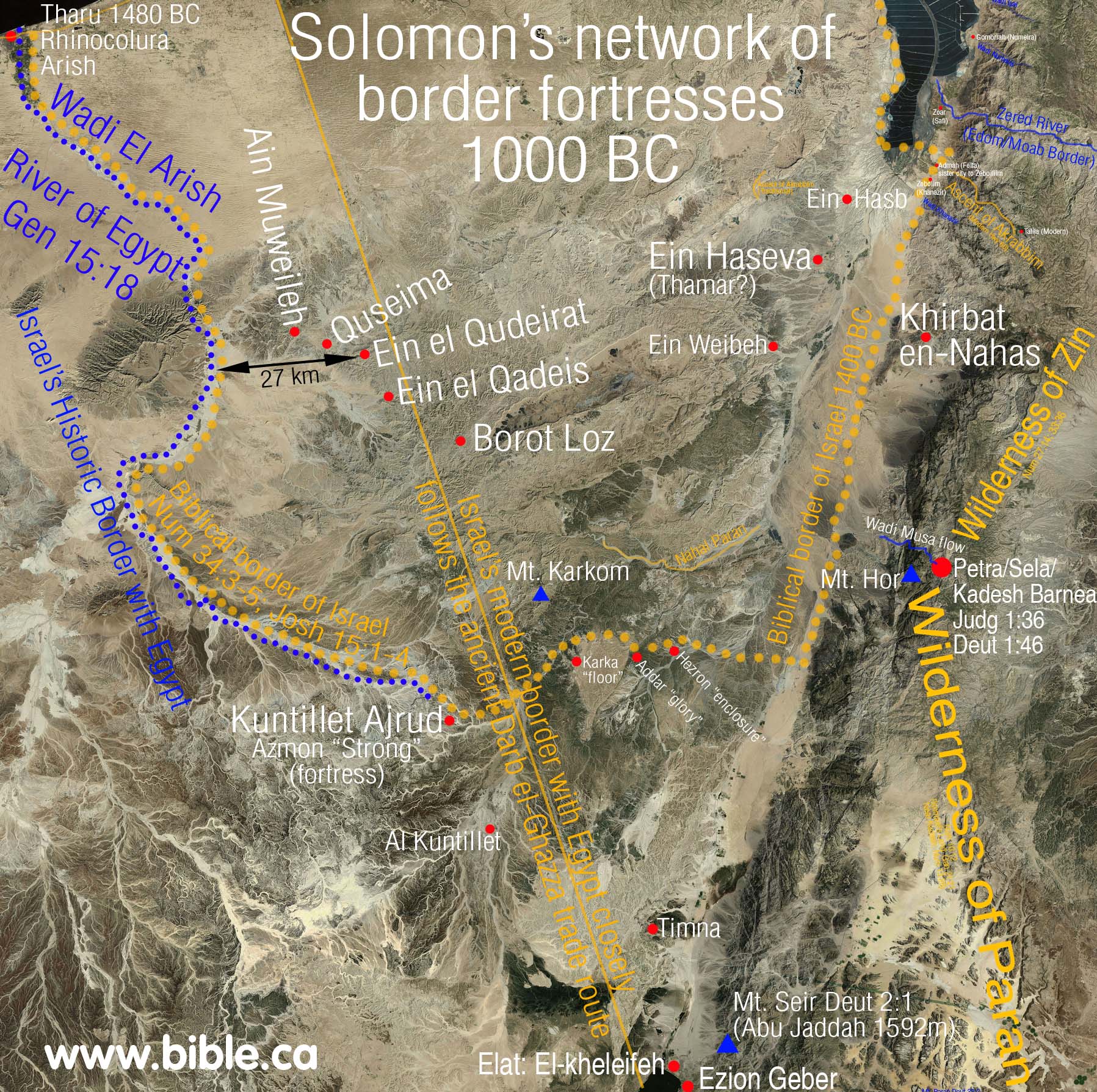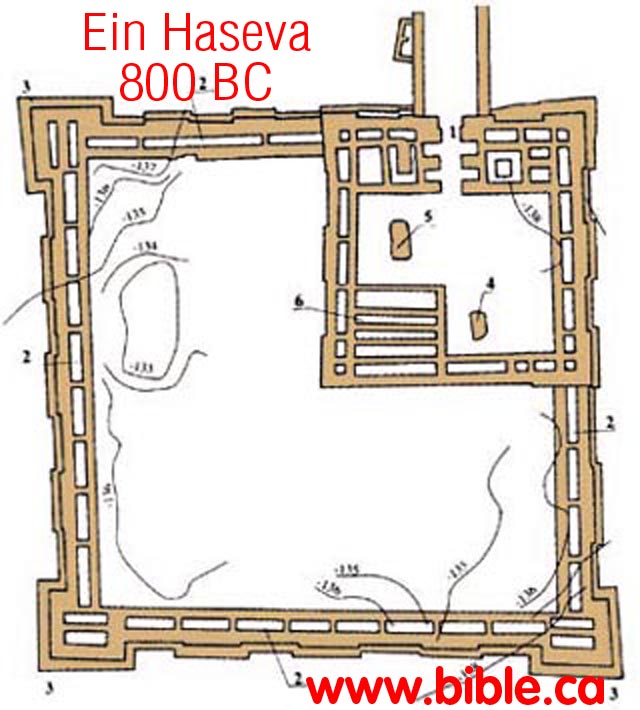Ein Haseva Fortress:
(One of Solomon's network of military border fortresses)


Introduction:
The fortress of Ein Haseva was one of many built by Solomon during his reign. Six different occupational levels have been discovered at this site ranging from 10th century BC to 7th century AD.
- There is no evidence that this site existed during the time of the Conquest in 1406 BC.
- Ein Haseva was on a strategic crossroads and was an important center needed to control the trade as well as establish and enforce an eastern boundary for the promised land. The popular candidate location for the Ascent of Akrabbim, is located just north of the main route that travels from the Negev through Ein Haseva, to the heartland of the promised land. It matters not that we reject this as the location for the Ascent of Akrabbim, for the fact remains that this was an ancient route used from the time of Solomon. Although it is a possible location for the Ascent of Akrabbim, there is a better transjordan choice, on the east side of the Arabah valley.
- The same kind of Negevite war pottery is found most of the border fortresses. The ambivalence of archeologists to use this crude ancient hand made pottery in establishing a specific date, like wheel made pottery, does not change the fact that if the site was built by Solomon, we would expect to find Negevite war. The absence, not the presence of this pottery is what would disqualify Solomon as the builder.
- The key here, is that the modern choice of Kadesh Barnea located at Qudeirat, is clearly wrong. For all of Solomon's border fortresses share so much in common, that none of them were in existence during the Exodus at 1446 BC.
A. Date of the fortress at En Haseva:
"Iron Age (tenth century BCE): Of three fortresses attributed to the Iron Age, the earliest (Stratum 6) probably dates to the tenth century BCE, to the period of the United Monarchy. The Stratum 5 fortress, the largest and best-preserved of the three, has been ascribed to the ninth-eighth centuries BCE. The latest fortress (Stratum 4), apparently concurrent with the Edomite Shrine and accompanying cult remains, and possibly constructed by Josiah (second half of the seventh century BCE), was destroyed after a relatively short existence around the time of the destruction of the First Temple (586 BCE)." (The Iron Age Fortresses at En Haseva, Rudolph Cohen, 1995 AD)
"Stratum 6 (The Early Fortress): Among the earliest remains uncovered at En Haseva are those of a rectangular structure (ca. 13.0x11.5 m) that may belong to the tenth century BCE. Uncovered beneath the piers of the fortress gate and to its west and south, the walls of the structure were built of silex. The impressive southwestern corner, built of large silex blocks, is preserved to the height of more than a meter. It appears to be a fortress, similar in plan to those found at several Iron Age sites in the central Negev (Cohen 1995)." (The Iron Age Fortresses at En Haseva, Rudolph Cohen, 1995 AD)
B. "Negevite" ware pottery found:
More on Negev Pottery.
- "Diggers retrieved a complete handmade Negbite cooking-pot, made of rather coarse ware and exhibiting very crude manufacturing, from the southeastern room of this fortress. Negbite ware has been found at Tell el-Kheleifeh (Glueck 1939:13f; 1940:17f; Pratico 1985:23f) and in all three fortresses uncovered at Kadesh-Barnea (Cohen 1981;1983a), dating from the tenth to the beginning of the sixth centuries BCE." (The Iron Age Fortresses at En Haseva, Rudolph Cohen, 1995 AD)
C. Strategic Location:
"En Haseva sits at a strategically crucial commercial crossroads, especially vital for the Arabian spice trade." (The Iron Age Fortresses at En Haseva, Rudolph Cohen, 1995 AD)
D. History of En Haseva built by Solomon:
"Stratum 6: Credit for the initial construction of the fortress at 'En Haseva (Stratum 6) must go to Solomon. Accepting the identification of En Haseva with Tamar (Aharoni 1963) joins it to the list of sites mentioned in 1 Kgs 9:17-18 as built by the king.9 The Stratum 6 fortress would have been part of the fortress settlement network set up by royal initiative during Solomon's reign (Cohen 1980; 1995). These outposts not only safeguarded the Negev highways but also defended the kingdom's southern border. Many of them, including (En Haseva, were destroyed in Pharaoh Shishak's military campaign against the region in ca. 926 BCE (Mazar 1957; 1986:139-50; Kitchen 1986:293-300, 432-47). As much as scholars continue to debate the date, function, and origin of these fortresses, we continue to interpret them as the product of a central authority projecting its power in defense of crucial trade routes. So too, Solomon, despite the debate that swirls round his historicity, can be credited with significant, archaeologically detectable achievements." (The Iron Age Fortresses at En Haseva, Rudolph Cohen, 1995 AD)
The middle fortress (Stratum 5) from the ninth-eighth centuries BCE occupies roughly four times the area extent of contemporaneous Negev fortresses. Perhaps the site should be regarded as a small administrative city, like the Judean fortified city of Tel Beersheba, rather than a large fortress. Courtesy of the Israel Antiquities Authority. ..."Another possibility is that the [Stratum 5] fortress was built by Amaziah (798-769 BCE), the son of Joash, who was diligent in fortifying his kingdom both from within and without, and, after instituting reforms in the army, went to war with Edom. He defeated the Edomites in the Valley of Salt, in the northern Arabah, and then went on to conquer Sela (2 Kgs 14:7), renaming it Joktheel, and settling descendants from the Tribe of Judah there. Was it from this fortress that he set out against the Edomites? Or was the fortress built during the reign of Amaziah's son Uzziah (769-733 BCE; 2 Kgs 15:1), the powerful and active king who "built Elot and restored it to Judah" (2 Chr 26:2; 2 Kgs 14:22;), fortified the borders of his kingdom "and built towers in the wilderness" (2 Chr 26:10), and, like his father before him, strengthened his army in order to prevail over his enemies (2 Chr 26:13)? Although there is a strong possibility, based on archaeological, historical, and biblical considerations, that Jehoshaphat was the builder of the Stratum 5 fortress, there are, nevertheless, archaeological remains dating to Uzziah, and a case may be made to support his having engineered at least part of the construction of this fortress." (The Iron Age Fortresses at En Haseva, Rudolph Cohen, 1995 AD)
Here are two drawings of the middle fortress, Stratum 5:


By Steve Rudd: Contact the author for comments, input or corrections.

Go To Start: WWW.BIBLE.CA
